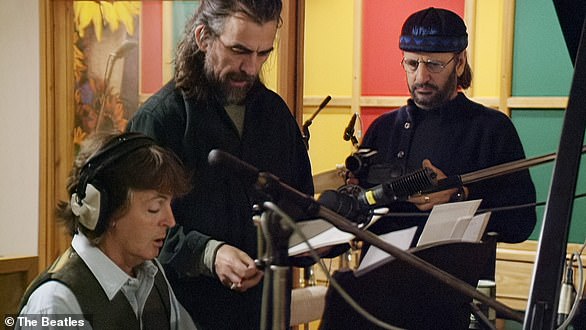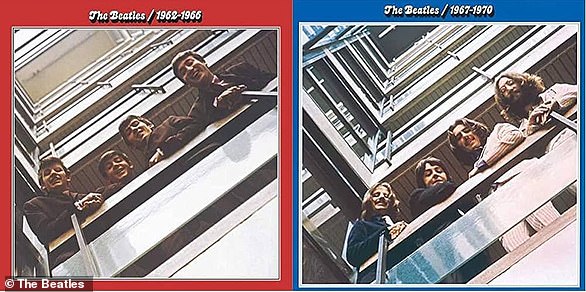How John Lennon’s final interview could be saved after the Star Wars soundtrack blacked out the Beatles star’s voice in a clip filmed just two months before his murder
“Now and Then” has its origins as a composition John Lennon recorded at his New York home in the Dakota Building in the late 1970s – about a decade after the Beatles broke up.
Lennon played the song with a cassette recorder running on his piano, although the composition was unfinished at the time.
This demo – which has been on YouTube for years – was only intended as a rough run-through and was accompanied by electronic ‘hissing’ and buzzing from the socket.
Lennon played the song with a cassette recorder running on his piano, although it was unfinished at the time. He is pictured here during studio sessions for Imagine (1971)
Fourteen years after Lennon was brutally murdered, his widow Yoko Ono presented a tape of the recording to Paul McCartney.
With Ono’s blessing, the other three Beatles had agreed to work on the song with the goal of finally completing it, along with three other Lennon compositions (“Free as a Bird,” “Real Love” and “Grow Old With Me’).
Free as a Bird and Real Love were completed and released in 1995 and 1996 respectively, but work on Now and Then stopped after two days and the song was shelved. Work never began on Grow Old With Me, which had already appeared on Lennon’s posthumous album ‘Milk and Honey’.
The Now and Then demo in particular was plagued by the buzz of the net and, in McCartney’s words, ‘every time I wanted a little more of John’s voice, this piano would come through and obscure the picture’.
Fortunately, George Harrison recorded acoustic and electric guitar parts for the song that have been preserved.

Paul McCartney, George Harrison and Ringo Starr work on a John Lennon demo in the mid-1990s
More than a quarter of a century later, a breakthrough came thanks to machine audio learning (MAL) technology developed by Peter Jackson and his team at WingNut Films.
MAL can identify and separate different sounds on a recording, even if they were originally recorded on the same track.
The AI was able to take John’s demo, remove the piano and mains hum and render the vocals ‘crystal clear’.
The easy part was adding new music to finally complete the song.
Paul McCartney provided a new bass part, a slide guitar solo, electric harpsichord and a piano line that mimicked John’s original on the demo.
Ringo Starr added drums and percussion, while both remaining Beatles contributed vocals.
Guitar recorded by George Harrison before the song was recorded in 1995 and was an integral part of the final track’s arrangement, according to producer Giles Martin, son of ‘fifth Beatle’ George Martin.
As a finishing touch, a string arrangement secretly recorded at Capitol Studios in LA was added, as well as excerpts of three-part harmony singing recorded by Lennon, McCartney and Harrison in the 1960s.

Now and Then is included on the reissue of the legendary Beatles compilation The Blue Album, which, along with The Red Album, was released on Friday
Beatles fans are hopeful that Paul McCartney and Giles Martin will create new mixes of Free as a Bird and Real Love using MAL, with much clearer lead vocals from Lennon.
Unlike the new single Now and Then, these two Beatles songs, completed in the 1990s, retain Lennon’s original piano and feature a relatively weaker, fainter voice.
Peter Jackson told the Sunday Times last week that there might be more “new” Beatles music to be found between the recordings and rehearsals in January 1969 (the subject of his “Get Back” documentary).
“We could take a performance of Get Back, separate John and George, and then have Paul and Ringo add a chorus or harmonies,” Jackson said.
‘Maybe you’ll end up with a nice song, but I haven’t had any conversations with Paul about that yet.
“It’s fanboy stuff, but certainly conceivable.”
Now and Then has been billed as the ‘last Beatles song’, but fans know there are more songs in the vaults that have not yet had an official release.
Perhaps the best known of these, the 13-minute avant-garde piece ‘Carnival of Light’, was recorded by all four Beatles at Abbey Road in January 1967.
Beatles historian Mark Lewisohn described the experimental, improvised song as “distorted” and “hypnotic.”
“It’s not that big of a deal in my world because I heard it,” he said. “And it won’t be a problem in anyone else’s world once they hear it! It’s not that great, but it’s important in its own way.”
